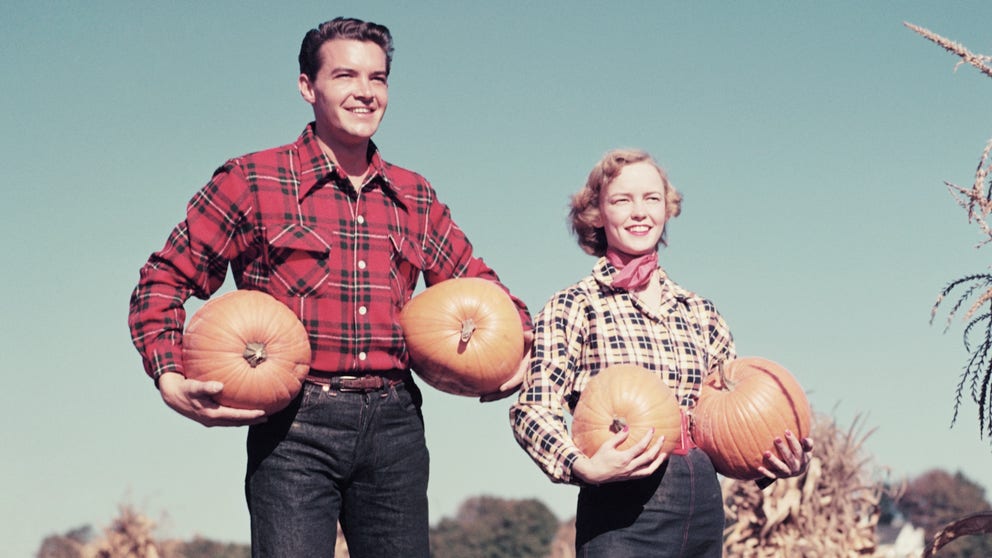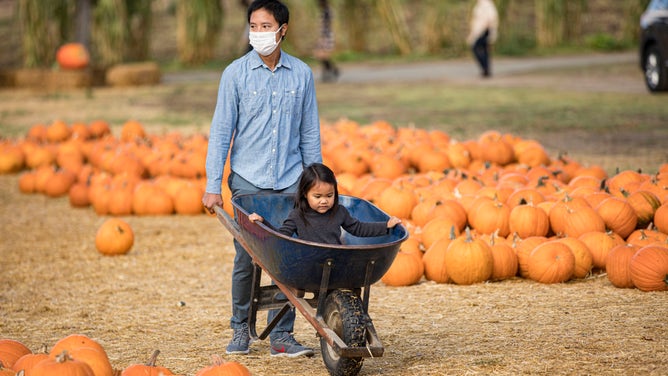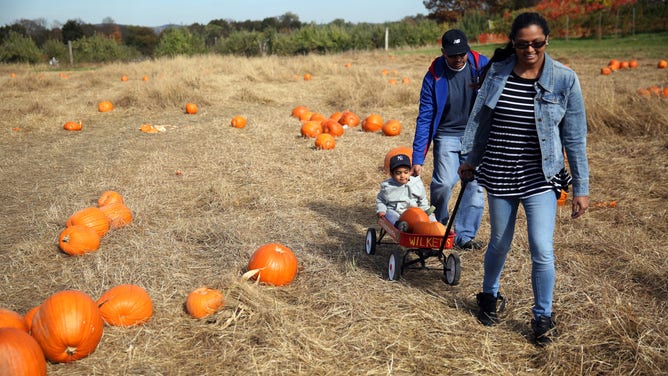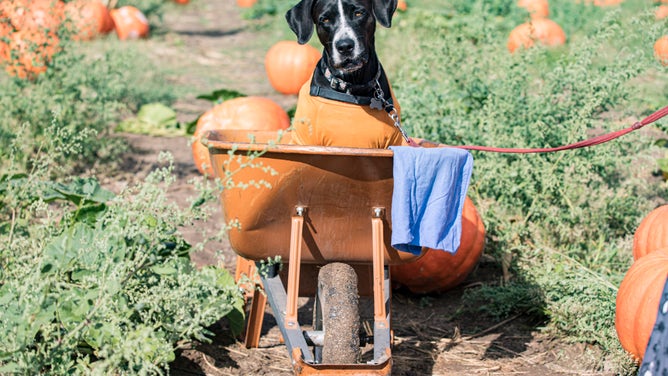Why is the pumpkin a symbol of fall and Halloween?
From a vegetable of necessity to an edible icon, the pumpkin experienced a dramatic transformation in American culture. Pumpkins and jack-o-lanterns now symbolize fall, Halloween and Thanksgiving. A lit pumpkin can also mean "welcome trick-or-treaters."
How the pumpkin became an American icon
From a vegetable of necessity to an edible icon, learn how the humble pumpkin experienced a dramatic transformation in American culture.
It’s that time of year again when you see the plump, orange gourds nearly everywhere -- jack-o'-lanterns on front porches, in pies and lattes and even in haunted houses.
But how did the humble pumpkin become the belle of the autumn ball?
Back to its roots
PUMPKIN WEIGHING 2,749 POUNDS WINS CALIFORNIA CONTEST, TOPS PREVIOUS WORLD RECORD
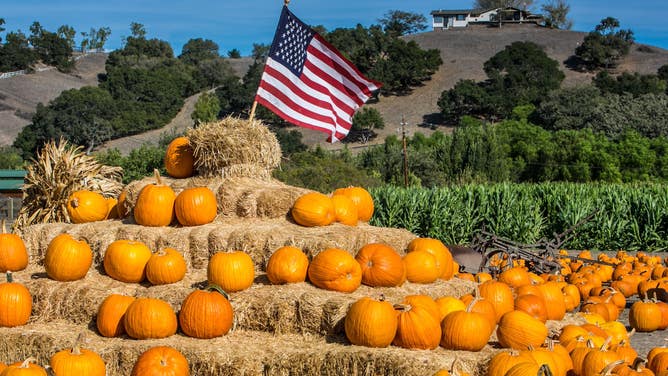
An American flag sits atop a mountain of pumpkins and straw bales in Solvang, California.
(George Rose / Getty Images)
The story of the pumpkin began in North America, where the vegetable was first cultivated thousands of years ago. For much of that time (and still to this day for many cultures), the pumpkin was largely cooked in savory dishes.
When English colonists arrived in North America and were introduced to the pumpkin in the 17th century, they too began using the vegetable, but not as the novelty item as we see it today.
"It was a food of last resort," said Cindy Ott, Professor of History and Museum Studies at the University of Delaware and author of ‘Pumpkin: The Curious History of an American Icon.’
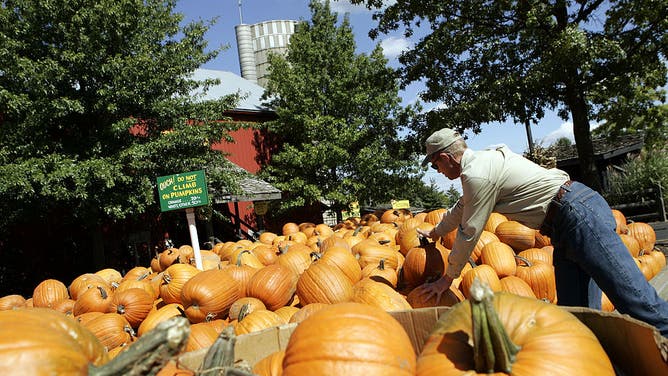
Dave Bengston readies his pumpkin farm for the start of the season in Homer Glen, Illinois, in September 2006.
(Scott Strazzante/Chicago Tribune/Tribune News Service via Getty Images / Getty Images)
"When [colonial farmers] couldn't manage to produce wheat or cabbage or any of the foods that they were used to having, they could often substitute the very prolific pumpkin because it grew like a weed," she added.
Essentially, the pumpkin became associated with an old-fashioned way of making a living off the land.
Ripening popularity
HERE'S WHAT TO DO WITH YOUR OLD PUMPKINS
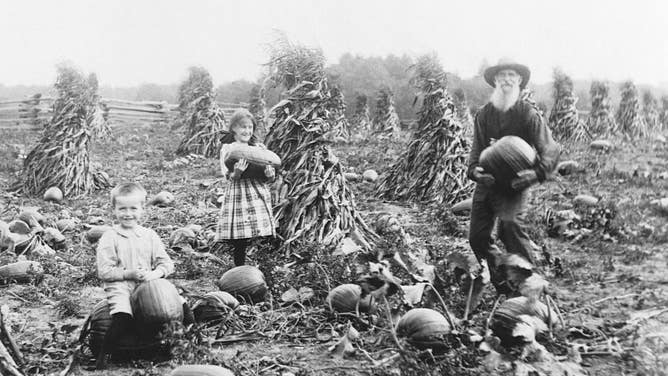
Grandpa Fairbrother and his grandchildren Edith and George gather pumpkins in a field.
(Minnesota Historical Society / Corbis / Getty Images)
Fast-forward to the 19th century, when the country experienced a big expansion of industrial agriculture. With more access to a greater variety of produce, Americans no longer needed to rely on pumpkins for food.
This shift to industrial agriculture also reduced the need for people to grow their own food, so many people left their farms and moved to the cities. However, this shift from an agrarian lifestyle proved to have an interesting effect on many people – they began to feel nostalgic about farm life.
WHAT IS THE PERFECT WEATHER FOR GROWING PUMPKINS?
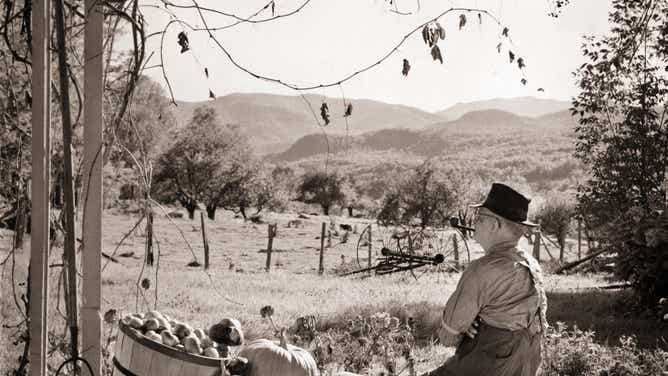
A farmer sits on his porch on an autumn day.
(H. Armstrong Roberts / Classicstock / Getty Images)
"Many Americans like to imagine themselves as farmers at heart — the values it represents, that you're toiling in the soil, working in nature and hard work, and it creates a sense of independence," Ott said.
So, the pumpkin, the hearty vegetable that was once eaten out of necessity, became celebrated as it connected urbanized Americans to the agrarian lifestyle they wanted to hold onto.
All pumpkin, everything
HOW TO STOP SQUIRRELS, OTHER CRITTER FROM EATING YOUR PUMPKINS
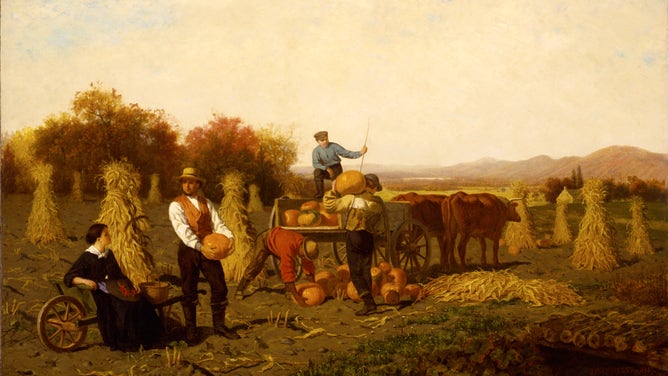
Farmers harvest pumpkins in this 1867 painting "October". Artist: John Whetten Ehninger.
(Heritage Art / Heritage Images / Getty Images)
Around the same time, the pumpkin’s symbolism of the farm and harvest started being expressed in American culture.
According to Ott, people living in the city weren’t eating the pumpkin on a daily basis, but they started putting pumpkin imagery in paintings and poetry. Because of the pumpkin's association with the harvest, it increasingly became a part of the national harvest celebration of Thanksgiving as a pie.
"It's not because of the taste of the pumpkin but because of what it represents," said Ott. "You sweeten it, and you turn it into a dessert to celebrate something special — then, you're sweetening the ideas associated with it".
"They're eating pumpkin for its meanings, not for its meat," she noted.
Pumpkin spice up your life

Pumpkin imagery on non-edible items.
(Goran Kosanovic / The Washington Post / Getty Images)
This consumption of its meanings, the ideas behind the pumpkin, only grew over the years.
Pumpkins can now be found in a variety of items, such as coffee and salsa, and pumpkin imagery can be found on a number of non-edible goods, such as clothes and household decorations. Even cookies that don’t have pumpkin in them but are decorated with an image of a pumpkin are still consumed because of what the pumpkin represents.
Also, many people drive for hours to visit a pumpkin farm just to pick pumpkins and be surrounded by them for a fall afternoon.
THE PAGAN AND CHRISTIAN ORIGINS OF HALLOWEEN
"It's just this spectacular symbol of natural abundance," Ott said. "It's huge. It grows like a weed. So, it represents these ideas of nature and natural goodness more than anything else that we associate with fall at harvest time."
It’s been a long journey for the hearty gourd to go from a vegetable of last resort to the poster child of fall, family and farms.
While some resistance to a few pumpkin-themed items has cropped up, the deeper meaning of pumpkins doesn’t seem to be going away anytime soon.
